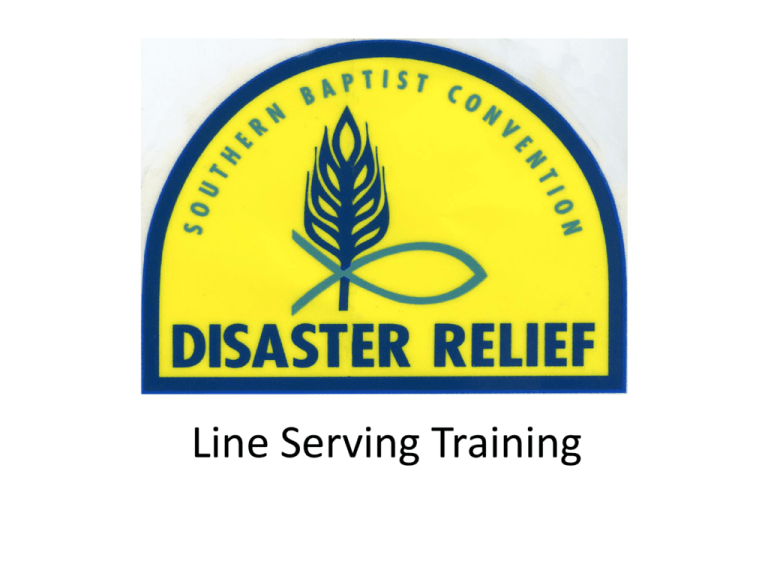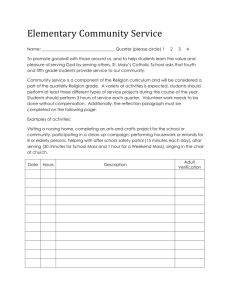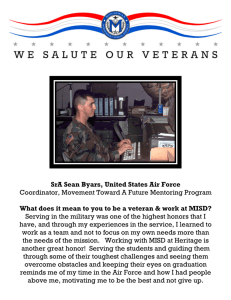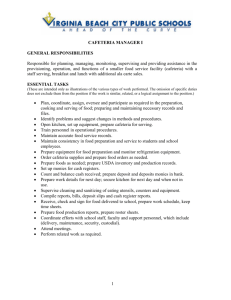Training DR Line Serving 9-3-14
advertisement

Line Serving Training Line Serving is Composed of Three Jobs 1. Serving food directly to disaster victims and volunteers 2. Organizing food to be sent out on Emergency Response Vehicles (ERVs) 3. Organizing food for a driveby line Requirements of Direct Serving 1. 2. 3. 4. 5. 6. Locating and setting up line Cleaning up the area before serving Organizing the line Serving the food Monitoring the serving line for safety Cleaning up the line after serving LOCATING AND SETTING UP THE LINE •Easy access to kitchen for cooks and servers •Flow leads to eating area away from work or storage areas •Determine placement of extra food- must be on pallet Cleaning up the area Get rid of clutter, wires, and hoses in serving area. Clean tables with detergent and warm water Sanitize with solution made of 2 tablespoon bleach to a gallon of water -temperature less than 100° F. Prevents evaporation and loss of disinfecting qualities Use test strips to verify strength Organizing the Line •Determine placement of food on table – example: clam shells, entrée, vegetable, fruit or dessert, bread or snack, cutlery •Obtain necessary serving utensils: slotted spoons, solid spoons, tongs, etc. with correct portion size •Determine number of servers needed •Obtain supplies from inventory: cups, plates, cutlery, napkins, snacks, etc. •Count number of meals served – server with clamshells counts shells used Monitoring the Serving Line for Safety •Monitor and maintain food temperature •Keep the area clean – wipe up spills immediately •Keep area free of clutter •Use only food from approved supplier Cleaning up the Line After Serving Take unused food to disposal or storage area Take dirty utensils to sanitation crew Clean up area and restock for next meal -get plates, cups, etc from inventory crew Organizing food for ERVs 1. Locate staging area 2. Be sure all food is ready before putting on pallet 3. Monitor area for safety 4. Clean up area after ERVs have gone Requirements for each ERV Check with Red Cross or Salvation Army to determine -how many meals for each ERV - what time it needs to leave -post this info for cooks in order of ERV departure Insure that cooks follow the list -This is the most important thing you can do -If an ERV does not get the food on time, it results in a bottleneck for the cooks and a blown schedule for the ERVs Determine number of Cambros needed by each ERV so order will be complete Drive-by Line Bulk distribution Individual meals REMEMBER! All food handlers must observe the Health Department regulations of the community in which they are operating! They can, and probably will, inspect us. PERSONAL GROOMING Shower and shampoo daily Wear clean clothes – short sleeves recommended Wear an apron – it is not a hand towel!! Leave jewelry at home No smoking within 25 yards of food preparation, serving, and storage areas, and propane – better NO SMOKING HAND WASHING Frequent and thorough hand washing is one of the most IMPORTANT ways to prevent the spread of microorganisms and illness. Hand Washing •When you start to work •After you use the restroom •After handling raw food •After touching hair, face, or any part of your body •After sneezing, coughing, or blowing nose •After eating, drinking, or smoking •After cleaning or taking out garbage •After touching anything that may contaminate hands It is acceptable to have a container of soapy water or bleach water available to dip hands in somewhere in the middle of the area when changing gloves. How to wash your hands •Use warm water •Wet hands and apply antibacterial soap •Scrub under and around nails •Rub hands together, up to elbows for at least 20 seconds •Rinse thoroughly •Dry with disposable towel •Use disposable towel to turn off faucet and to open restroom door Thermometers •Use thermometers to make sure of proper food temperatures •It is crucial to keep track of foods’ temperature while it is stored, prepared, and served •Use only thermometers designed for food usage •NSF Label SAFE Food Temps •Cook - 180°F •Hold – 145°F •Cool – 40°F •Freeze – 0°F DANGERZONE!!! RULE OF 4s • Cold foods must be under 40°F • Hot foods must be over 140° F • If between, use within 4 hours • Remember 40 – 140 – 4 Between 40 and 140 for 4 hours – forget it! Caps, Gloves, Aprons Required Use vinyl or Nitrile gloves. Latex gloves are not allowed by the Red Cross due to allergies and sensitivities to Latex. Change often: after touching non sanitized items and when wet with perspiration Beard Nets Required Prevent Food Borne Illnesses Food poisoning: Salmonella, Shigella, E-coli, Campylobacter, Staphylococcus, and other coliform bacteria Hepatitis-A Spread by: Improper: hand washing, cleaning procedures, temperatures, and cooling Food handler’s illness such as colds, flu, etc. Food Safety mistakes do cause illness Food Handling Acceptable Foods -Commercial supplier -Canned or frozen -No home cooked -No individually donated Food Handling Menu is planned by the head cook based on the inventory on hand. The food is obtained from inventory manager. Cambros •Insulated food container •Use liner •Label top with •Type of food •Meat, vegetable, fruit •Date and Time filled •Temperature of food •Number of servings •Size of servings •Destination or ERV number Always use liners Work area must be cleaned and sanitized Associational Trailers • Prepare up to 5,000 meals daily – Propane burners – Grill – Rice cookers – Tilt skillets or convection ovens may be brought in Unit One 48 foot trailer 3 tilt skillets 6 convection ovens OTHER DUTIES Remember the three rules: Be flexible Be flexible Be flexible There are times we need to work in a different area, and we need to be willing. Cooks are most often asked to assist in line serving or in sanitation. If you have the opportunity, ride in the ERV with the Red Cross. Dishwashing • Sanitation team • Power steamer • Three sinks Soap and water 110° F to 120° F Rinse water 110° F to 120° F Sanitize (bleach) 75° F to 100° F 1 tbsp. bleach per gallon of water Immerse for 2 minutes Devotions and Debriefing • At the end of each day – Everyone should attend – Discuss activities of the day – Discuss problems that occurred – Mitigate stress by sharing concerns • Look for ways that God has been at work in your life, that of co-workers and victims – Assignments for next day will be made – Brief devotional – Do not let this replace your personal devotions




